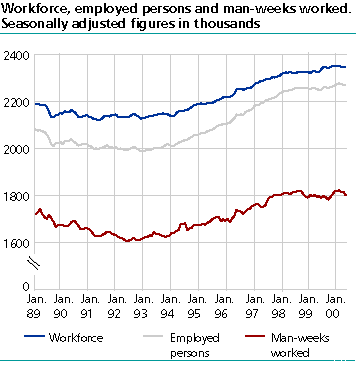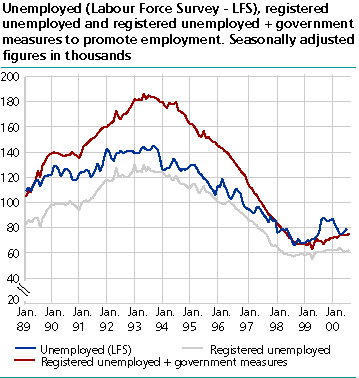Content
Published:
This is an archived release.
Stable labour force participation
Seasonally adjusted figures indicate a decrease in employment from the second to the third quarter 2000. Seasonally adjusted unemployment figures show a corresponding rise last quarter.
Around 73.9 per cent of the population aged 16-74 were either employed or unemployed in the third quarter 2000, 16 000 more than in the same quarter last year. The labour force participation rate as a whole remained unchanged, but it increased for women and decreased for men.
The number of employed increased by 12 000, or 0.5 per cent, last year. Compared with the third quarter 1999, retail trade and business services had a considerably increase in employment. Primary industries and manufacturing, on the other hand, showed a decline in employment.
Growth among women
82 000 persons were unemployed in the third quarter 2000, accounting for 3.5 per cent of the labour force. According to the seasonally adjusted figures, the unemployment increased from the second to the third quarter after a decrease during the first six months. The figures show that the unemployment rate at present is 0.2 percentage point higher than one year ago. From the third quarter last year to the third quarter this year the unemployment increased from 3.3 to 3.8 per cent among women and decreased from 3.3 to 3.2 among men.
The number of long-term unemployed was almost unchanged last year. Long-term unemployed are those who at the time of the survey had been continuously unemployed for more than half a year. The rate declined from 17 to 16 per cent.
There were 69 000 underemployed in the third quarter, i.e. part-time employed seeking more work. This is almost the same as one year ago. As a percentage of part-time employed, this corresponds to 12.6.
Continued decline in unemployment in EU and OECD
While the seasonally-adjusted unemployment in Norway rose from 3.2 to 3.4 from May to August, it fell by 0.1 percentage point on an average both in the EU- and the OECD-countries. In August the unemployment rate was 8.3 in EU and 6.5 in OECD. The unemployment rate was 4.1 in USA, 4.8 in Denmark and 5.9 in Sweden.
Man-weeks worked
The growth in man-weeks worked last year was 37 000 (2.3 per cent). In per cent this is a considerably higher growth than in employment (0.5 per cent). This is mainly due to the fact that the percentage of people on holiday leave was lower this year than last year.
Fewer temporary employed
There were 210 000 temporary employed in third quarter this year, 17 000 less than in the same quarter last year. The rate of temporary employment was relatively highest in the primary industries and in hotel and restaurant industry. Health and social work represented the greatest decline.
Continued growth in sickness absence
Around 82 000 employed people were temporarily absent due to sickness the entire survey week in the third quarter. From the same quarter last year the illness-related absence rate increased from 3.7 to 4.2 for women and from 2.9 to 3.1 for men.
Strongest growth in Østfold and Vest-Agder
The LFS has published county quarterly figures for the first time. Published are employment figures by sex and county of residence and as per cent of all persons in each group. From the third quarter 1999 to the same quarter this year Østfold and Vest-Agder had the greatest increase in employment. The two counties contributed together with around half of the total growth last year. The other counties showed only minimal changes in the total number of employed.
Uncertain seasonally adjusted figures
Quality tests show that the seasonally adjusted LFS unemployment figures are uncertain. The seasonal-adjustment method has problems identifying a seasonal pattern in this series of figures. The random results are relatively large compared to the seasonal component, hence one must keep in mind that the unemployment figures contain a particularly high degree of uncertainty. Statistics Norway plans to publish seasonally adjusted LFS figures based on the observed seasonal pattern after the readjustment in 1996.
Contact
-
Arbeidsmarked og lønn
E-mail: arbeidsmarked@ssb.no
-
Erik Herstad Horgen
E-mail: erik.horgen@ssb.no
tel.: (+47) 93 08 68 62
-
Håvard Hungnes Lien
E-mail: havard.lien@ssb.no
tel.: (+47) 40 90 26 06


